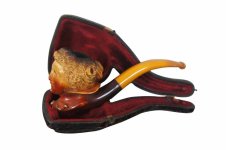As stated before, all meerschaum pipes are dipped in beeswax by the carver after the carving of the pipe is complete. Different carvers will use different wax (i.e. white, yellow, brown, red, blue, and even green), which is why you can find the colored meerschaum pipes on different websites. White is the most commonly used wax though. Some pipes have a heavier coating of wax than others.
Some carvers use a process called calcinated which gives a stained look on the pipe. In the 1800s it was common to find a pipe that looked cherry red which was calcinated by the carver. More recently the carvers calcinated the pipe giving that black charring look around the top of the bowl. It was commonly used on African meerschaum pipes back when they were still being produced. Some carvers still use that technique today though not a common.
In the 1700 and 1800's meerschaum pipes were dipped in sperm whale oil. It wasn't until the late 1800's/early 1900's that beeswax became common use for coating the meerschaum pipes. The reason for the wax is that's what holds in the color. Meerschaum naturally expresses the tars and oils, and by coating the pipe with wax, the wax holds those tars and oils in which gives the pipes our coloring. For those that handle there pipes a lot and possibly wear off some of the wax, people will re-wax them. Typically, not necessary, but some people like to do it. I've done it a handful of times. Some of my pipes have benefited from it, but others have not.









